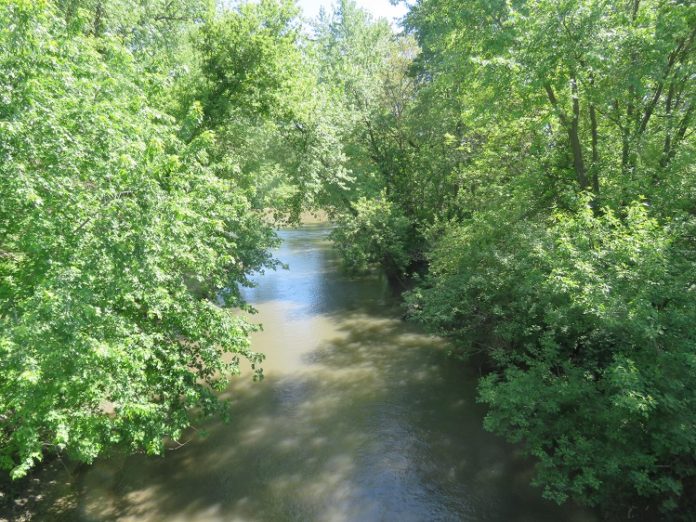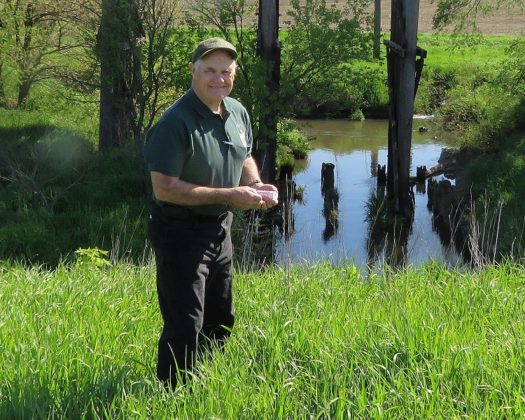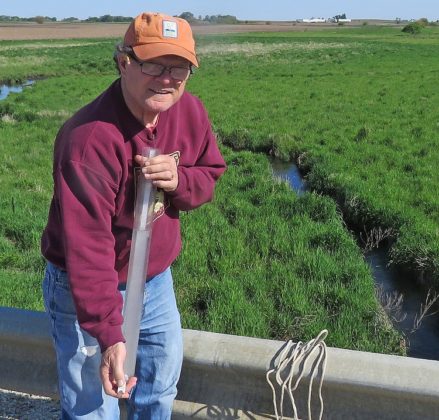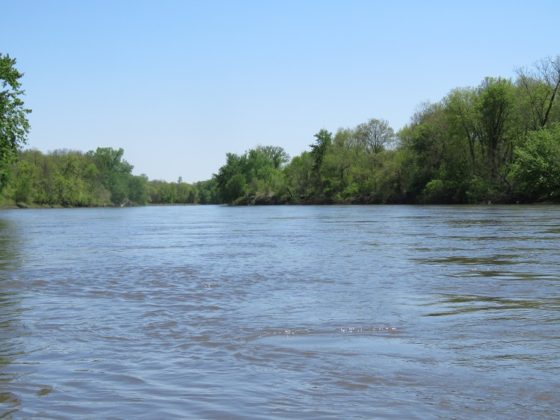
The Des Moines Water Works has announced plans to expand its nitrate removal system, doubling the size of the current facility. This will mean a rate increase for the people of Des Moines.
The current nitrate removal system was built in 1991 at a cost of $4.1 million and is the largest nitrate removal system in the country and perhaps in the world.
In 2016 the system ran for 65 days, costing ratepayers more than $600,000. This year the system was turned on May 2 and according to my water testing, it will run for much of the summer.
Shame on the Iowa Legislature for doing nothing to solve the nitrate problem, and shame on the farm community for not putting more conservation practices in place to reduce farm field runoff.
I tested 15 streams this month as part of a larger testing effort of the Raccoon River Watershed Association. Of those 15 streams, 14 were over the acceptable EPA limit of 10 milligrams per liter (mgm/L).
If the stream being tested has a nitrate reading of more than 10 milligrams per liter (mgm/L), then the stream is considered to be polluted (sometimes called “impaired”). The higher the number, the more polluted the stream.
If the stream is above 10 mgm/L, then it is polluted by all accepted standards. We were only testing for nitrate May 13.
Panther Creek southwest of Adel had the highest reading at 22 mgm/L or more than two times the acceptable limit. It is a very polluted stream.
Nitrate comes from many sources, farm fertilizer runoff, city sewage systems, poor septic tanks, golf courses and some natural processes. The Iowa DNR reports about 80 percent of surface water nitrate comes from farm field runoff.
If the water in the Raccoon River is reading more than 10 mgm/L for nitrate, then the Des Moines waterworks must do extra processing to clean the water and reduce the nitrate to 10 mgm/L or lower in order to be with in federal regulations. This extra processing increases the cost of the drinking water.
Drinking water with a nitrate reading of 10 or more can cause Blue Baby Syndrome in infants. In adults it not clear what the ill effects are. Infants have a type of hemoglobin in their blood that differs from adult hemoglobin, which is the chemical in blood that carries oxygen to our cells. Nitrate blocks the ability of the baby’s blood to carry oxygen, so they turn blue.
In adults, University of Iowa studies have shown a correlation between high nitrates in drinking water and bladder, kidney and urinary cancers. However, this is only a correlation and not definitely proved causation.
Frog Creek was tested north of Perry at Highway 144. It had the lowest reading, maybe because the stream was coming from a marsh or wetland. Marshes and wetlands hold the water, and plants are able to absorb and so reduce the nitrate load.
The transparency number measures how deep (in centimeters) a person can see into the water. It is a measure of the silt load. But forget about the transparency number for now, and just concentrate on the nitrate number.
Testing conducted by the Raccoon River Watershed Association
HUC 12 Tributaries: Raccoon River, May 13, 2017
SITE TIME NITRATES mgm/L Transparency Comments
Frog Ck 9:20AM 5+ mgm/L 35 Cm output of a marsh
Hwy 144
Snake Ck 9:35 10+ 30
Hwy 144
Snake Ck Marsh 9:40 10 45
W Ave/280St
Snake Marsh 9:45 5 60 very calm, no current
Buttress Ck 10:55 15 48
Hwy 30
Hardin Ck 11:10 20 40
Hwy 30
Raccoon R 11:20 20 25
Hwy 30
Greenbrier Ck 12:10 18 20 fishing line in tree
Site D1 west of Dawson
Fanny’s Branch 12:25 12 60
Hull Av/160St 14:00 15 60 not a listed site
small creek
Elm Branch 14:10 20+ 30 cliff swallows getting
D18 mud
Swan Branch 14:15 20 45 shallow
D17
Mosquito Creek 14:45 18 15 cows access to creek
at Linden Rd
Panther Creek 15:15 20+ 25 mink with baby
near P58
Adel dam 15:45 15 — kids in water, water snake





















The lower the transparency number, the more polluted the stream is with silt or soil. Silt carries phosphates and other nutrients that cause the water to turn green with algae. Excessive algae can cause fish kills and make the water unfit for swimming. Silt is easy for the waterworks to remove and not so serious a problem as nitrates. The testing did not include tests for other chemicals or bacteria.
While these numbers do show elevated nitrate levels in local water ways, they do not show the entire picture. We have had a wet spring, and that will increase nitrate levels in the water. This is due to more than 10,000 pounds of naturally occuring organic nitrogen in the soil per acre. The Iowa Ag Water Alliance has shown that nitrogen leaching from farm fields is the same for soybean fields as it is for corn fields, but ammonia is only added to corn fields, so there is obviously something else going on in the soil. High nitrate levels aren’t necessarily fertilizer mismanagement, and while it’s convenient to broadly paint this as an issue caused by farmers, it can only be solved by everyone seeking a common goal rather than pointing fingers. Perhaps a good place to start would be to recognize that weather can impact nitrate levels in waterways. Mr. Harden as a retired science teacher is pushing an agenda rather than analyzing data and asking questions about what the numbers mean. This is certainly his prerogative, but it gives me pause regarding his credibility as a local environmental figure.
Agenda? My agenda is for Iowa to have clean water. What did I say that is incorrect? I spent 14 years as an elected soil and water commissioner for Dallas County, so I think I have a good understanding of the problem and all the factors that affect the nitrate levels in Iowa waterways.
Ray Harden
As I understand it, when the nitrate levels are above 10 in the waterworks output, notices must be posted in resturants warning customers, and the waterworks customers must also be notified. So what are the output numbers?
Ray Harden’s article is spot on. The Gulf dead zone did not exist until after farming activities began using nitrogen as fertilizer, which began in the mid-1960s. Iowa and especially the Raccoon River basin are at the top of the list of nitrogen contributors in the Mississippi River drainage. Along with nitrogen pollution, cyanobacteria (commonly referred to as blue-green algae) is a crisis beginning to unfold within the Raccoon River drainage system. Cyanobacteria is a serious problem in surface water sources in the U.S., including Iowa. Cyanobacteria grow and multiply quickly where there are high nutrients (nitrogen and phosphorus) in warm, calm waters. Blooms create blue to green murky water, visible surface scum and a foul odor. The blooms can spread across the water but tend to accumulate in shoreline areas. While algae blooms are a nuisance, certain forms of blue-green algae can also produce toxins that can make humans and animals sick. Contact with water with more than 20 parts per billion of microcystin represents a risk of cyanotoxin-associated illnesses including breathing problems, stomach upset, skin reactions and even liver damage. Inhaling water droplets containing microcystin can cause runny eyes and nose, cough and sore throat, chest pain, asthma-like symptoms or allergic reactions. Pets and other animals that swim or drink the water can be exposed to deadly levels of microcystin. Last summer the Des Moines Waterworks detected a dangerous level of this hazardous bio-substance traveling down the Raccoon River, above the Des Moines Waterworks intake. Luckily, Des Moines has three water sources and was able to switch to the Des Moines River intake until the threat passed. The DNR has begun routinely closing beaches around the state each summer due to these blooms. The evidence is clear: Nitrogen, phosphorous, bacteria and silt from agricultural activities are threatening the health of Iowa’s citizens and reducing quality of life in our state.
Currently, Iowa is undergoing a huge expansion of the hog CAFO industry. My property adjoins one of the Iowa DNR’s approved Manure Management Plan fields that serves as a disposal field for a 4,400-head hog finisher unit. This disposal field is discharging consistently above 10 mg/l of nitrate and many readings around 20 mg/l. Phosphates are considerably above the 0.03 mg/l that causes algae blooms. These discharges are entering wetlands and a creek that feeds the Des Moines River. It’s sad that the governor and Iowa Legislature believe that one industry has the right to take from our communities the clean water and air that nature has provided us.